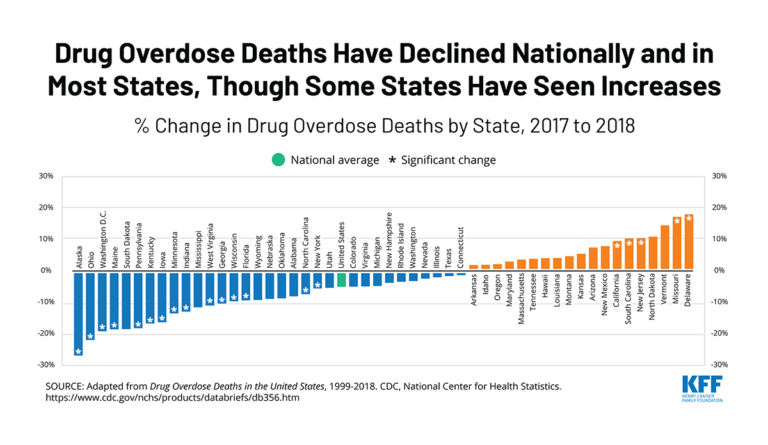Opioid Ups and Downs
For the first time since 1999, the national drug overdose death rate declined in 2018, an important marker of the nation’s response to the opioid epidemic.

Read Time: 2 minutes
Published:
For the first time since 1999, the national drug overdose death rate declined in 2018, dropping by 4.1% compared to 2017. The graph shows how 14 states and Washington D.C. saw their drug overdose death rates significantly decrease.
These changes are important markers of the nation’s response to the opioid epidemic, which has evolved in three waves since it began in 1999. In 2017, when the epidemic peaked, over 70,000 people died of a drug overdose.
Early mortality emerging from the opioid epidemic has largely contributed to recent downward trends in life expectancy of Americans. For the first time in five years, the national life expectancy rate saw a slight uptick.
Even as life expectancy increased and overall drug overdose deaths declined in 2018, overdose death rates for cocaine and meth, and for synthetic opioids like fentanyl, all continued to rise. Fentanyl has driven the third wave of the opioid epidemic since 2013.
The Centers for Disease Control and Prevention has responded to the opioid epidemic in five key ways: improving state tracking of opioid related data, improving local communities’ capacity to track and respond to overdoses, updating provider guidelines for opioid prescriptions, informing consumers of the risks of opioids, and, most crucially, partnering with first responders and law enforcement to increase naloxone usage. Constant evaluation is vital in understanding how the national landscape changes and whether the improvements in 2018 will extend into 2019.
Databyte via Kaiser Family Foundation. “Drug Overdose Deaths Have Declined Nationally and in Most States, Though Some States Have Seen Increases.” 6 February 2020.



